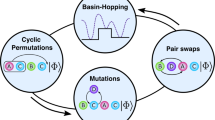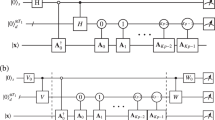Abstract
Exact first-principles calculations of molecular properties are currently intractable because their computational cost grows exponentially with both the number of atoms and basis set size. A solution is to move to a radically different model of computing by building a quantum computer, which is a device that uses quantum systems themselves to store and process data. Here we report the application of the latest photonic quantum computer technology to calculate properties of the smallest molecular system: the hydrogen molecule in a minimal basis. We calculate the complete energy spectrum to 20 bits of precision and discuss how the technique can be expanded to solve large-scale chemical problems that lie beyond the reach of modern supercomputers. These results represent an early practical step toward a powerful tool with a broad range of quantum-chemical applications.
This is a preview of subscription content, access via your institution
Access options
Subscribe to this journal
Receive 12 print issues and online access
$259.00 per year
only $21.58 per issue
Buy this article
- Purchase on Springer Link
- Instant access to full article PDF
Prices may be subject to local taxes which are calculated during checkout


Similar content being viewed by others
References
Feynman, R. P. Simulating physics with computers. Int. J. Theor. Phys. 21, 467–488 (1982).
Lloyd, S. Universal quantum simulators. Science 273, 1073–1078 (1996).
Head-Gordon, M. & Artacho, E. Chemistry on the computer. Physics Today 61(4), 58–63 (2008).
Hung, L. & Carter, E. A. Accurate simulations of metals at the mesoscale: Explicit treatment of 1 million atoms with quantum mechanics. Chem. Phys. Lett. 475, 163–170 (2009).
Chelikowsky, J. R. et al. Pseudopotentials on grids: Application to the electronic, optical, and vibrational properties of silicon nanocrystals. J. Comput. Theor. Nanosci. 6, 1247–1261 (2009).
Dreuw, A. & Head-Gordon, M. Failure of time-dependent density functional theory for long-range charge-transfer excited states: The zincbacteriochlorin-bacterlochlorin and bacteriochlorophyll-spheroidene complexes. J. Am. Chem. Soc. 126, 4007–4016 (2004).
Levine, B. G. & Martinez, T. J. Isomerization through conical intersections. Ann. Rev. Phys. Chem. 58, 613–634 (2007).
Lee, P. A., Nagaosa, N. & Wen, X.-G. Doping a Mott insulator: Physics of high-temperature superconductivity. Rev. Mod. Phys. 78, 17–85 (2006).
Van Voorhis, T. & Head-Gordon, M. Benchmark variational coupled cluster doubles results. J. Chem. Phys. 113, 8873–8879 (2000).
Abrams, D. & Lloyd, S. Simulation of many-body fermi systems on a universal quantum computer. Phys. Rev. Lett. 79, 2586–2586 (1997).
Kassal, I. Jordan, S. P., Love, P. J., Mohseni, M. & Aspuru-Guzik, A. Polynomial-time quantum algorithm for the simulation of chemical dynamics Proc. Natl Acad. Sci. USA 105, 18681–18686 (2008).
Zalka. C. Efficient simulation of quantum systems by quantum computers. Proc. R. Soc. Lond. A 454, 313–322 (1998).
Kassal, I. & Aspuru-Guzik, A. Quantum algorithm for molecular properties and geometry optimization. J. Chem. Phys. (in the press); preprint at http://arxiv.org/abs/0908.1921 (2009).
Lidar D. A. & Wang, H. Calculating the thermal rate constant with exponential speedup on a quantum computer. Phys. Rev. E 59, 2429–2438 (1999).
Aspuru-Guzik, A., Dutoi, A., Love, P. J. & Head-Gordon, M. Simulated quantum computation of molecular energies. Science 309, 1704–1707 (2005).
Brown, K. R., Clark, R. J. & Chuang, I. L. Limitations of quantum simulation examined by simulating a pairing Hamiltonian using nuclear magnetic resonance. Phys. Rev. Lett. 97, 050504 (2006).
Clark C. R., Metodi, T. S., Gasster, S. D. & Brown, K. R. Resource requirements for fault-tolerant quantum simulation: The ground state of the transverse Ising model. Phys. Rev. A 79, 062314 (2009).
Somaroo, S., Tseng, C. H., Havel, T. F., Laflamme, R. & Cory, D. G. Quantum simulations on a quantum computer. Phys. Rev. Lett. 82, 5381–5384 (1999).
Yang, X., Wang, A. M., Xu, F. & Du. J. Experimental simulation of a pairing Hamiltonian on an NMR quantum computer. Chem. Phys. Lett. 422, 20–24 (2006).
Friedenauer, A., Schmitz, H., Glueckert, J. T., Porras, D. & Schaetz, T. Simulating a quantum magnet with trapped ions. Nature Phys. 4, 757–761 (2008).
Gerritsma, R. et al. Quantum simulation of the Dirac equation. Preprint at: http://arxiv.org/abs/0909.0674 (2009).
Vidal, G. Efficient classical simulation of slightly entangled quantum computations. Phys. Rev. Lett. 91, 147902 (2003).
Schmidt-Kaler, F. et al. Realization of the Cirac–Zoller controlled-NOT quantum gate Nature 422, 408–411 (2003).
Leibfried, D. et al. Experimental demonstration of a robust, high-fidelity geometric two ion-qubit phase gate. Nature 422, 412–415 (2003).
O'Brien, J. L., Pryde, G. J., White, A. G., Ralph, T. C. & Branning, D. Demonstration of an all-optical quantum controlled-NOT gate. Nature 426, 264–267 (2003).
Plantenberg, H. J., de Groot, P. C., Harmans, C. J. P. M. & Mooij, J. E. Demonstration of controlled-NOT quantum gates on a pair of superconducting quantum bits. Nature 447, 836–839 (2007).
Pashkin, Y. A. et al. Quantum oscillations in two coupled charge qubits. Nature 421, 823–826 (2003).
Knill, E., Laflamme, R. & Milburn, G. J. A scheme for efficient quantum computation with linear optics. Nature 409, 46–52 (2001).
Kok, P. et al. Linear optical quantum computing with photonic qubits. Rev. Mod. Phys. 79, 135 (2007).
Lanyon, B. P. et al. Experimental demonstration of a compiled version of Shor's Algorithm with quantum entanglement. Phys. Rev. Lett. 99, 250505 (2007).
Lanyon, B. P. et al. Simplifying quantum logic using higher-dimensional Hilbert spaces. Nature Phys. 5, 134–140 (2009).
Kitaev, A. Quantum measurements and the Abelian Stabilizer Problem. Preprint at: http://arxiv.org/abs/quant-ph/9511026 (1995).
Dobsicek, M., Johansson, G., Shumeiko, V. S. & Wendin, G. Arbitrary accuracy iterative phase estimation algorithm as a two qubit benchmark. Phys. Rev. A 76, 030306(R) (2007).
Nielsen, M. A. & Chuang, I. L. Quantum Computation and Quantum Information (Cambridge Univ. Press, 2001).
Helgaker, T., Jorgensen, P. & Olsen, J. Modern Electronic Structure Theory (Wiley, 2000).
Xiu-Mei, L., Jun, L. & Xian-Ping, S. Experimental realization of arbitrary accuracy iterative phase estimation algorithms on ensemble quantum computers. Chinese Phys. Lett. 24, 3316–3319 (2007).
Braunstein, S. L. et al. Separability of very noisy mixed states and implications for NMR quantum computing. Phys. Rev. Lett. 83, 1054–1057 (1999).
Chiaverini J. et al. Implementation of the semiclassical quantum Fourier transform in a scalable system. Science 308, 997–1000 (2005).
Nielsen, M. A. Optical quantum computation using cluster states. Phys. Rev. Lett. 93, 040503 (2004).
Wu, L.-A., Byrd, M. S. & Lidar, D. A. Polynomial-time simulation of pairing models on a quantum computer. Phys. Rev. Lett. 89, 057904 (2002).
Farhi, E., Goldstone, J., Gutmann, S. & Sipser, M. Quantum adiabatic evolution algorithms with different paths. Science 292, 472–475 (2000).
Grangier, P., Sanders, B. & Vuckovic, J. (eds) Special issue: Focus on single photons on demand New J. Phys. 6, (2004).
Cheung, J., Migdal, A. & Rastello, M.-L. (eds) Special issue: Single-photon: detectors, applications, and measurement methods. J. Mod. Opt. 56, 2–3 (2009).
Dür, W., Bremner, M. J. & Briegel, H. J. Quantum simulation of interacting high-dimensional systems: the influence of noise. Phys. Rev. A 78, 052325 (2008).
Jané, E., Vidal, G., Dür, W., Zoller, P. & Cirac, J. I. Simulation of quantum dynamics with quantum optical systems. Quant. Inf. Comp. 3, 15–37 (2003).
Hehre, W. J., Stewart, R. F. & Pople, J. A. Self-consistent molecular orbital methods I. Use of Gaussian expansions of slater type atomic orbitals. J. Chem. Phys. 51, 2657–2664 (1969).
Szabo, A. & Ostlund, N. Modern Quantum Chemistry: Introduction to Advanced Electronic Structure Theory (Dover Publications, 1996).
Liao, Y. et al. Electro-optic integration of embedded electrodes and waveguides in LiNbO3using a femtosecond laser. Opt. Lett. 33, 2281–2283 (2008).
Acknowledgements
We thank A. Perdomo, A. Steinberg, P. J. Love, A. D. Dutoi, G. Vidal and A. Fedrizzi for discussions. We acknowledge financial support from the Australian Research Council (ARC) Federation Fellow and Centre of Excellence programs, and the IARPA-funded US Army Research Office Contracts W911NF-0397 and W911NF-07-0304. B.J.P. was the recipient of an ARC Queen Elizabeth II Fellowship (DP0878523) and I.K. a recipient of the Joyce and Zlatko Baloković Scholarship. A.A.G. thanks the Alfred P. Sloan Foundation and the Camille and Henry Dreyfus Foundation for support.
Author information
Authors and Affiliations
Contributions
B.P.L., J.D.W., I.K., M.M., A.A.G. and A.G.W. conceived and designed the experiments, B.P.L., G.G.G., M.E.G. and M.P.A. performed the experiments, B.P.L. and G.G.G. analysed the data, J.D.W. performed the classical preprocessing. All authors discussed the results and co-wrote the manuscript.
Corresponding authors
Ethics declarations
Competing interests
The authors declare no competing financial interests.
Supplementary information
Supplementary information
Supplementary information (PDF 663 kb)
Rights and permissions
About this article
Cite this article
Lanyon, B., Whitfield, J., Gillett, G. et al. Towards quantum chemistry on a quantum computer. Nature Chem 2, 106–111 (2010). https://doi.org/10.1038/nchem.483
Received:
Accepted:
Published:
Issue Date:
DOI: https://doi.org/10.1038/nchem.483
This article is cited by
-
Review of Applications of Quantum Computing in Power Flow Calculation
Journal of Electrical Engineering & Technology (2024)
-
Quantum simulation of preferred tautomeric state prediction
npj Quantum Information (2023)
-
Stochastic representation of many-body quantum states
Nature Communications (2023)
-
Orbital-optimized pair-correlated electron simulations on trapped-ion quantum computers
npj Quantum Information (2023)
-
Chip-scale simulations in a quantum-correlated synthetic space
Nature Photonics (2023)



